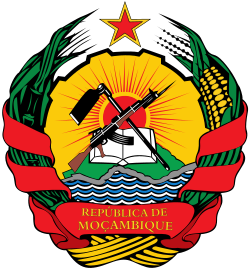Emblem of Mozambique
| Emblem of Mozambique | |
|---|---|
 | |
| Armiger | Republic of Mozambique |
| Adopted | 1990 |
| Motto | República de Moçambique "Republic of Mozambique" |
The national emblem of Mozambique was adopted in 1990 in the Constitution of Mozambique Article 194, which states the design and meaning of the device. It shows a gearwheel bordered by corn stalks and sugarcane. In the middle, there is a red sun over a map of the country in green, blue waves, an AK-47 crossed with a hoe, and a book. The wreath is tied to a ribbon bearing the name of the country. The emblem is rendered in a socialist heraldry style similar to those used by the republics of the Soviet Union.
Description
[edit]As described in Article 194,[1] the various parts of the emblem each have a special symbolism, including:
- the corn stalk and the sugar cane represent agricultural wealth
- the cogwheel represents labor and industry
- the book represents education
- the hoe for "peasantry and agriculture production"
- the AK-47, with a bayonet attached, for "defense and vigilance"
- the red star represents the spirit of international solidarity of the Mozambican people".
- the red sun symbolizes the building of a new life
From 1975-1982, the map of Mozambique was brown instead of green. Along with this change of colour, the position of the wreath was changed, the text was changed from black to gold, and a gold border was added around the red star.
In 1990, with the implementation of the new constitution, the name of the country was changed from República Popular de Moçambique to República de Moçambique, and the text on the emblem was changed accordingly.
Mozambique's parliamentary opposition would specifically like to see removed the image of the Kalashnikov assault rifle, which symbolizes the nation's struggle for independence, according to press reports.[2]
Historical coats of arms
[edit]In 1935, the Portuguese colonies were officially assigned coats of arms that followed a standard design pattern.[4]
- Early version of coat of arms
- Temporary coat of arms representing Portuguese Mozambique at the Portuguese colonial exhibition (1934).
- Provisional coat of arms of Portuguese East Africa in the 1930s.
- Coat of arms of Portuguese East Africa from May 8, 1935 to June 11, 1951.
- Coat of arms of Portuguese East Africa from June 11, 1951 to June 25, 1975.
- Lesser coat of arms from May 8, 1935 to June 25, 1975.
- Coat of arms of the People's Republic of Mozambique (1975–1982)
- Coat of arms of the People's Republic of Mozambique (1982–1990)
References
[edit]- ^ "'The Constitution of The Republic of Mozambique'" (PDF). Archived from the original (PDF) on 2020-09-25. Retrieved 2009-06-15.
- ^ "Are you passionate about your flag?". BBC News. December 23, 2005. Archived from the original on November 5, 2021. Retrieved January 15, 2018.
- ^ "Portaria 8098: Aprova as ordenações das armas das colónias que, nos termos da Constituïção e do Acto Colonial, formam o Império Colonial Português", Diário do Govêrno n.º 104/1935, Série I de 1935-05-08, 597-599 (in Portuguese), archived from the original on 2021-07-28, retrieved 2020-04-12
- ^ published in the Diário do Govêrno[3]
Article 194 The emblem of the Republic of Mozambique shall contain as its central elements a book, a gun and a hoe, superimposed on a map of Mozambique, representing, respectively, education, defense and vigilance, and the peasantry and agricultural production. Below the map the ocean shall be represented. In the center shall be the rising sun, symbol of the building of a new life. Enclosing all this shall be a toothed wheel, symbolizing labor and industry. Surrounding the toothed wheel there shall be, to the right and left respectively, an ear of maize and a piece of sugar cane, symbolizing agricultural wealth. At the bottom there shall be a red strip with the inscription "Republic of Mozambique."


 French
French Deutsch
Deutsch






